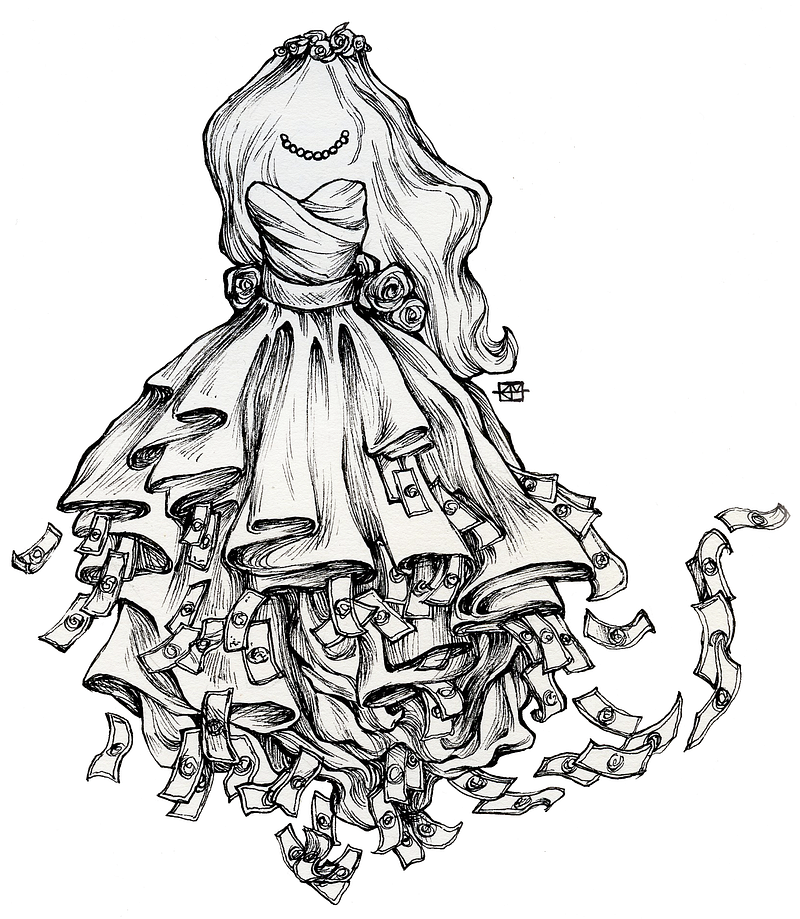I Now Pronounce You … In Debt
The astronomical prices of throwing a one-day event are getting out of hand, many younger couples are opting for different variations of this cultural affair
Personal Essay by NAOMI GISH | Illustration by KEARA MULVIHILL

Nearly 3.5 million couples get married each year in the United States. I will be joining the masses July 21 along with roughly 6,200 other couples. Before that I will be frantically deciding which Paperless Post save-the-date to email to over 300 people and relaying my wedding vision to my wedding planner, while also attempting to stay on a tight budget.
I, along with 44 percent of brides this wedding season, are heavily utilizing our parents budget while booking vendors and venues. While deciphering the costs and relying heavily on my planner and countless podcasts and magazine articles for help in whittling down costs, I’ve found that though astronomical prices of bouquets and table runners are all that’s on the market these days, it wasn’t always like this.
A quick answer to this may be simply that traditions have changed since the time my mother wore a gunny-sack wedding dress and got married at the church around the corner, while no more than 50 guests looked on. But people also didn’t used to have an average of a 15-month engagement to plan an extravagant evening for 150-plus guests. They were perhaps not bombarded by the wedding industry advertising to them their entire lives creating an expectation that this had to be the largest party ever, putting them in debilitating debt for the next five years.
There is a pressure when it comes to considering “the best day of your life.” There may be no such thing as a typical wedding, but there is a general understanding that this party I am throwing is something that will define us as a couple amongst our friends and family for the next decade.
Prices are doubling. The average wedding in the U.S. costs $35,329. I’ve become numb to seeing this number as I watch my own expenses pile up on top of one another.
An engagement ring 10 years ago was $2,600 and today it will, on average cost the groom $5,000. The entire wedding budget has also been doubled. While parents are still paying for a lot of the wedding, couples are getting married later in life and the combined budgets have made for a price spike all-around.
However, there is an emerging trend in millennials to combat these prices. DIYing their way to victory over the wedding budget.
The big white wedding dress is negotiable. Nontraditional venues are being chosen over the hotel or cathedral. Cupcakes are being created by family members instead of hiring cake designers (I’ll admit, this last one is on my agenda).
While millennials are now planning these affairs as mason jar, hobo-chic intimate-looking parties, these new traditions are now becoming costly in other ways.
The planning often begins two years before the actual day which is referred to by “The Big Wedding Planning Podcast,” (my current bible) as a full-time job. This full-time job still usually sits atop the bride’s shoulders who is also working a real full-time job elsewhere in her life. With all these hours of planning, nothing is left up to chance and stress soon ensues.
With the social media culture of young couples, photography and videography are now becoming more art pieces than they are used as tools to capture and remember the special day by. The wedding day isn’t even the only day a couple will get their photos taken. There is the engagement session, the bridal shoot and the first look before the actual ceremony and reception have even taken place. The average wedding photographer in the Seattle area costs $2,000 in 2018 and this doesn’t include the videography at all.
In a wedding with a traditional bride and groom, the tasks involved in planning a wedding have typically fallen to the bride because society views them as more feminine in nature and so are not advertised toward the groom as being something he is responsible for. The most recent generation has been slowly reversing this, involving the groom in the wedding planning process as well. While this seems to me to be beneficial as I’ve personally found, the only thing found online about this trend now though is that every groom is villainized into a “groomzilla” once he takes any part in the planning process.
As a bride, I am expected to hire a wedding planner, a month-of coordinator, a stationer, a photographer, a videographer, a cosmetologist, a catering service, a cake designer, a florist, an officiant, a set crew, a DJ and goodness knows who else I’m forgetting.
All in all, I figure that at the end of the day when my feet are killing me, I’ll have a $45 Washington State marriage license and a groom. When it’s all said and done in 50 years, those are probably the only things that I will truly treasure from my wedding day.
